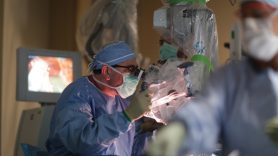Braving a surgical no man’s land
The Skull Base Tumor Program is an all-pro team of surgeons and specialists tackling tumors in very hard-to-reach places.


Eight miles in the air while piloting a flight from New Jersey to Houston, Gerald Ahrens’ life took an unexpected turn.
“I got a nosebleed that just wouldn’t stop,” says Ahrens, who flies charter and corporate jets. “Something just wasn’t right.”
That nosebleed 10 years ago was the beginning of a whirlwind journey that brought Ahrens to MD Anderson. Here, doctors found he had squamous cell cancer in his sinus cavity — the hollow, air-filled spaces in the bones around the nose.
Now 68 and cancer free, Ahrens was one of the early patients to benefit from MD Anderson’s Skull Base Tumor Program, which celebrates its 10th anniversary this year. Bringing together neurosurgeons, head and neck surgeons, radiation oncologists and other health care professionals, the program treats patients who develop tumors at the base or “floor” of the skull, where the brain sits. This region includes the area behind the eyes and nose.
Franco DeMonte, M.D., who helped pioneer the program, says not all skull base tumors are cancerous, but all are rare and complex.
“Treating skull base tumors is challenging because they are very close to critical nerves and blood vessels in the brain, head, neck and spinal cord,” says DeMonte, professor in Neurosurgery. “Surgeons must carefully work around these delicate structures without damaging them.”
At MD Anderson, patients in the Skull Base Tumor Program are treated for a variety of cancers or noncancerous tumors that reside in the bones around the eyes or inner ear, in the roof of the nasal cavity, or in the sinus cavities. These include chordomas (cancerous bone tumors at the base of the skull), meningiomas (aggressive tumors that originate in the lining of the brain and are usually benign) and acoustic neuromas (noncancerous tumors that develop on the nerve that connects the inner ear with the brain).
Skull base tumor surgery can affect a patient’s hearing, sight, smell, speech and appearance. Because of this, supportive services step in to provide balance therapy, physical therapy, audiology, speech therapy, plastic reconstructive surgery, dentistry and ophthalmology to patients.
“Supportive services bring another dimension of expertise to the program,” says DeMonte. “And because these teams are so good at what they do, our patient outcomes and quality of life are very much improved. Everyone on this team contributes and it’s the patients who most benefit.”
Most patients undergo surgery, and at MD Anderson, many skull base tumor surgeries are performed endoscopically. Surgeons pass an endoscope — a long, thin tube equipped with a miniature light and a video camera — through a natural opening such as the nose to peer into the skull and locate the tumor. Various tiny surgical instruments, which allow the surgeon to shear away bits of the tumor, are introduced alongside the endoscope.
Because many skull base tumors are rubbery or fibrous and hard to cut out, tools are designed to scrape, pick, grasp, cut and suction as the surgeon whittles away the tumor.
“These tumors often adhere to critical structures like nerves and blood vessels, so extreme precision is necessary during removal,” says Ehab Hanna, M.D., professor in Head and Neck Surgery, who helped establish the program along with DeMonte.
In addition to leading-edge surgical techniques, MD Anderson patients have access to advanced radiation treatments such as proton therapy or gamma knife, as well as the latest chemo drugs.

“Surgery is the gateway for the majority of patients, but what makes our program truly multidisciplinary, and unlike any other program in the country, is what our colleagues in medical oncology, radiation oncology and other specialties offer,” DeMonte says. “If we can see patients with these difficult cancers at the right time and leverage the team’s full expertise, we can save lives.”
A recent study conducted by DeMonte and Hanna showed that 80% of patients who had their first surgery for sinus cavity cancer at MD Anderson survived 10 years, which is well beyond the average of 60%. Another study showed that during a 50-year time span, the survival rate for patients with sinus cavity cancer has increased from 30% to 75%.
“Before 1990, skull base tumors were considered to be residing in no man’s land, and often patients were told to go home and die,” Hanna says. “Now, the future is exciting and hopeful, especially at MD Anderson.”
The next step in the evolution of skull base surgery is to introduce robotics, which Hanna is exploring.
Mary Murrill came to MD Anderson in 2013 to be treated for an acoustic neuroma — a rare, noncancerous skull base tumor that develops on a nerve between the brain and inner ear.Patients often experience hearing loss, tinnitus or ringing in the ears, and dizziness.
“I thought I had a sinus infection, but antibiotics didn’t help,” says Murrill, who lives in Beaumont, Texas. “The pain in my ear was piercing, and the loud ringing noise kept me awake all night.”
Murrill’s doctor suggested she consult Paul Gidley, M.D., professor in Head and Neck Surgery. Gidley heads the Skull Base Tumor Program’s acoustic neuroma service, where, with DeMonte, he performs about 30 acoustic neuroma surgeries a year.
Gidley and DeMonte removed Murrill’s acoustic neuroma in an intricate 10-hour surgery that preserved her facial function and impacted both her hearing and balance. After working with an MD Anderson balance therapist to steady her equilibrium, Murrill is back on her feet.
“I felt so lucky knowing I was in the best of hands,” she says.












